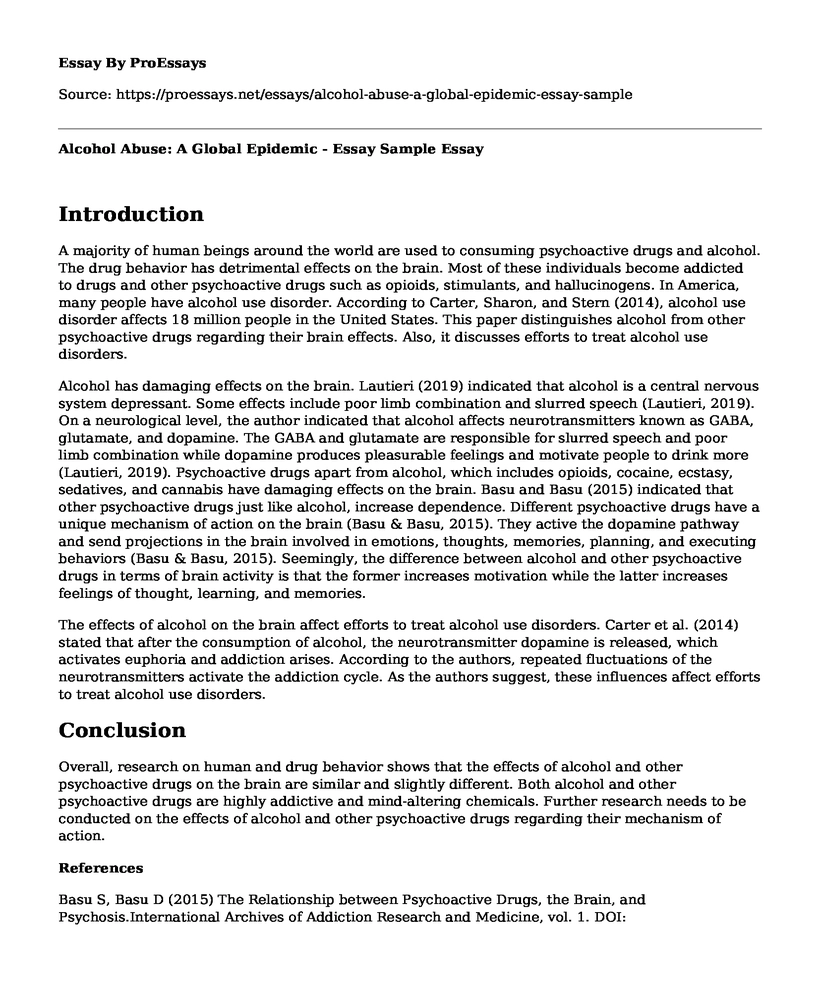Introduction
A majority of human beings around the world are used to consuming psychoactive drugs and alcohol. The drug behavior has detrimental effects on the brain. Most of these individuals become addicted to drugs and other psychoactive drugs such as opioids, stimulants, and hallucinogens. In America, many people have alcohol use disorder. According to Carter, Sharon, and Stern (2014), alcohol use disorder affects 18 million people in the United States. This paper distinguishes alcohol from other psychoactive drugs regarding their brain effects. Also, it discusses efforts to treat alcohol use disorders.
Alcohol has damaging effects on the brain. Lautieri (2019) indicated that alcohol is a central nervous system depressant. Some effects include poor limb combination and slurred speech (Lautieri, 2019). On a neurological level, the author indicated that alcohol affects neurotransmitters known as GABA, glutamate, and dopamine. The GABA and glutamate are responsible for slurred speech and poor limb combination while dopamine produces pleasurable feelings and motivate people to drink more (Lautieri, 2019). Psychoactive drugs apart from alcohol, which includes opioids, cocaine, ecstasy, sedatives, and cannabis have damaging effects on the brain. Basu and Basu (2015) indicated that other psychoactive drugs just like alcohol, increase dependence. Different psychoactive drugs have a unique mechanism of action on the brain (Basu & Basu, 2015). They active the dopamine pathway and send projections in the brain involved in emotions, thoughts, memories, planning, and executing behaviors (Basu & Basu, 2015). Seemingly, the difference between alcohol and other psychoactive drugs in terms of brain activity is that the former increases motivation while the latter increases feelings of thought, learning, and memories.
The effects of alcohol on the brain affect efforts to treat alcohol use disorders. Carter et al. (2014) stated that after the consumption of alcohol, the neurotransmitter dopamine is released, which activates euphoria and addiction arises. According to the authors, repeated fluctuations of the neurotransmitters activate the addiction cycle. As the authors suggest, these influences affect efforts to treat alcohol use disorders.
Conclusion
Overall, research on human and drug behavior shows that the effects of alcohol and other psychoactive drugs on the brain are similar and slightly different. Both alcohol and other psychoactive drugs are highly addictive and mind-altering chemicals. Further research needs to be conducted on the effects of alcohol and other psychoactive drugs regarding their mechanism of action.
References
Basu S, Basu D (2015) The Relationship between Psychoactive Drugs, the Brain, and Psychosis.International Archives of Addiction Research and Medicine, vol. 1. DOI: 10.23937/2474-3631/1510003
Carter, J., Sharon, E., & Stern, T. A. (2014). The management of alcohol use disorders: theimpact of pharmacologic, affective, behavioral, and cognitive approaches. The primary care companion for CNS disorders, 16(4), 10.4088/PCC.14f01683. doi:10.4088/PCC.14f01683
Lautieri, A. (Short and Long-term Effects of Alcohol. American Addiction Centers. Retrieved from https://americanaddictioncenters.org/alcoholism-treatment/mental-effects
Cite this page
Alcohol Abuse: A Global Epidemic - Essay Sample. (2023, Feb 27). Retrieved from https://proessays.net/essays/alcohol-abuse-a-global-epidemic-essay-sample
If you are the original author of this essay and no longer wish to have it published on the ProEssays website, please click below to request its removal:
- Paper Example on Open Immigration
- Feminine Identity Essay Example
- University Tries to Mend Racial Divisions Paper Example
- Essay Example on Venezuela: A Struggling Nation of Poverty and Culture Shock
- Essay Example on 19th-Century Homosexuality & Female Impersonation: A Historical Overview
- Gender Wage Inequality: Impact on Future Economy - Essay Sample
- Essay Example on Elvira's Story: An Immigrant's Journey for a Better Life







